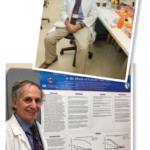Other findings raised the prospect of metformin having a potential role in knee osteoarthritis (OA), with an annual medial cartilage loss over four years significantly lower in metformin users than in non-users. This advantage was seen after adjustments for age, gender, body mass index, grade of knee OA, pain score and diabetes.6
David Pisetsky, MD, PhD, professor of medicine and immunology at Duke University School of Medicine, Durham, N.C., said single-cell RNA sequencing and mass spectrometry are providing new troves of gene-expression information down to the level of individual cells in tissue. “Because of the technology, we’ve probably accumulated more data in the last year than the preceding 50,” he said.
The new focus on tissue—rather than peripheral blood—is an important change in rheumatology, Dr. Pisetsky said.

Dr. Pisetsky
“As we begin to think about new approaches to therapy, having information at the site of inflammation is really key,” he said.
The Accelerating Medicines Partnership—a collaboration by the National Institutes of Health, the FDA, companies and nonprofit organizations—is transforming the approach to drug development, with $42.2 million dedicated to rheumatoid arthritis and systemic lupus erythematosus (SLE) for the application of these new technologies.
In one recent study, single-cell transcriptomics and mass cytometry together have helped define the state of inflammatory cells in RA through complex analysis of synovial tissue biopsy samples, Dr. Pisetsky said. The idea is to establish profiles for different cell types—fibroblasts, B cells, monocytes—that could be therapeutic targets.7
In SLE, researchers across several centers analyzed kidney samples using single-cell RNA sequencing, revealing multiple populations of myeloid cells, T cells and other cells that showed both pro-inflammatory and inflammation-resolving responses, chemokine receptors that were expressed widely and other observations.8
Recent research in vasculitis has clarified the role of neutrophil extracellular traps (NETs)—DNA strands that form a mesh-like material that traps bacteria and fungi but can also induce pro-inflammatory activity—in DADA2, a systemic vasculitis, Dr. Pisetsky said. Researchers found that adenosine triggered the formation of NETs. The findings, they say, suggest that modulating this formation could be a new and specific therapeutic angle for DADA2, and maybe other inflammatory diseases.9
‘Single-cell RNA sequencing and mass spectrometry are providing new troves of gene-expression information down to the level of individual cells in tissue.’ —Dr. Pisetsky
Dr. Pisetsky also described advances in the understanding of the processes involved in DNA sensing—in which sensors in the cytoplasm of cells respond to DNA that’s introduced during a viral or bacterial infection, a process that can lead to inflammation; genetic defects in the nucleases that degrade DNA can also increase DNA in the cytoplasm to trigger these receptors. Immune complexes that contain DNA can also enter cells, providing another source of stimulating DNA.


